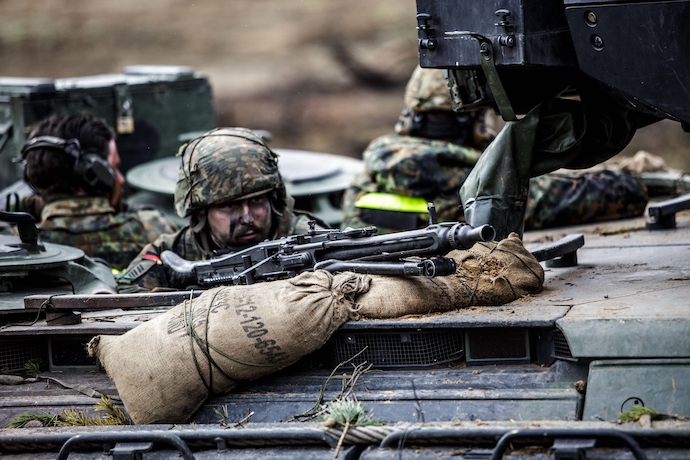
Germany’s March Back to the Barracks
Germany is undertaking a major military revival to counter Russian threats and reduce reliance on U.S. security guarantees.
Europe’s economic powerhouse is once again confronting the specter of war. As Russia presses its military advantage in Eastern Europe and Washington’s security commitments grow more ambiguous, Germany is embarking on a sweeping remilitarization effort—one with echoes, both anxious and deliberate, of its pre-WWII past.
Determined to place the Bundeswehr among Europe’s top-tier armed forces, Berlin is undertaking a military revival that will require a wholesale overhaul of its structure, doctrine, and spending. The path forward is steep: decades of complacency and post-Cold War demobilization have left the German military underfunded, undermanned, and strategically adrift.
A New Chancellor’s War Footing
Russia’s 2022 invasion of Ukraine was a geopolitical awakening for Berlin. It revealed, with uncomfortable clarity, how dependent Germany has become on Russian energy, on American defense guarantees, and on an outdated notion that peace was Europe’s default setting. That strategic inertia is being shaken by Chancellor Friedrich Merz, who entered office with a mandate shaped by both external threats and internal political turbulence, including a resurgent pro-Russian Alternative for Germany (AfD) party that has exploited German unease over defense and sovereignty.

Merz’s government has announced a $110 billion investment fund to overhaul the Bundeswehr and finally meet, if not exceed, NATO’s benchmark of 2% of GDP in defense spending. The spending will target critical deficiencies: secure communications, electronic warfare capabilities, armored mobility, missile defense, drones, and naval shipbuilding. The goal is to align Germany with neighboring Poland, whose own military expansion is casting a long strategic shadow across the continent.
Germany’s remilitarization is not just continental in scope. In recent months, its navy has engaged Houthi rebels in the Red Sea and joined allied exercises in East Asia, marking a clear pivot to Indo-Pacific engagement alongside France and the United Kingdom. This global presence is as symbolic as it is strategic: a signal that Germany intends to wield not just economic weight, but military heft.
A Bundeswehr Rebuilt—On Paper
Today’s Bundeswehr stands at roughly 180,000 personnel. For Europe, that’s substantial. But Berlin aims to push that figure to 200,000. On land, Germany operates 296 Leopard tanks and 350 infantry fighting vehicles, supplemented by an undisclosed number of armored personnel carriers. Its air force fields 85 Tornado and 140 Eurofighter Typhoon jets, with orders for an additional 35 Typhoons and 35 U.S.-made F-35s already underway. At sea, the navy comprises 65 vessels, including 11 frigates, six submarines, and five corvettes, along with support and auxiliary ships. Berlin has also acquired the Israeli-designed Arrow 3 missile system, capable of intercepting ICBMs.
The Bundeswehr has accumulated some experience through NATO and EU missions in the Balkans and Afghanistan—where 59 German soldiers were killed in action—and in the French-led Sahel operations in Mali. Though small in scale, these deployments provided crucial combat and logistics training. Berlin has even floated the possibility of peacekeepers in Ukraine, should the war settle into a frozen conflict.
The Human Deficit
Yet hardware is only one side of the remilitarization equation. The Bundeswehr faces an even more daunting challenge in recruitment and retention. With a graying population and a shrinking pool of eligible youth, expanding the armed forces will require more than patriotic appeals. In 2025, a leaked Bundeswehr report confirmed acute shortfalls in both enlisted and officer ranks. The average age of German active-duty personnel is now 34, indicating a significant wave of retirements is looming.
Restoring the Cold War-era conscription model is unlikely. The infrastructure that once supported universal service—barracks, training centers, administrative logistics—has long been dismantled. Instead, Berlin is exploring a conscription-lite system modeled on Finland’s approach, offering a blend of military and civil service. This could expand the pipeline of service members without the political cost of forced enlistment.
Retooling for Sustainability
For Germany’s defense effort to be more than a spending spree, it must be sustainable. That means cultivating a professional corps with career longevity, replenishing depleted artillery and missile stockpiles, and reducing reliance on foreign defense contractors. Long dismissed as unessential, domestic defense production is now rebounding, driven by Russia’s war in Ukraine and America’s shifting global priorities. Rheinmetall, Germany’s leading arms producer, stands poised to scale up rapidly.
But strategy, like manufacturing, requires narrative. Germany will need more than budget increases and weapons systems to restore its military ethos. The government must articulate a compelling rationale for service—one rooted not only in national pride, but in the very real threats posed by Russia’s revanchism and the fragility of Europe’s postwar order. Deployments to Lithuania and other Eastern flank states, as well as joint Indo-Pacific missions, may offer a new sense of purpose.
Toward Strategic Reawakening
Germany’s remilitarization is no longer theoretical. It is material, political, and increasingly urgent. But rebuilding an effective military force from decades of atrophy will not be easy. Recruiting and retaining personnel, revitalizing domestic industry, and navigating coalition politics remain formidable hurdles.
Still, the imperative is clear: if Germany is to avoid becoming a strategic bystander in its own neighborhood, it must restore the credibility of the Bundeswehr—not just as a symbol of strength, but as a functional pillar of European security. The challenge ahead is as much about national will as it is about weapons.
